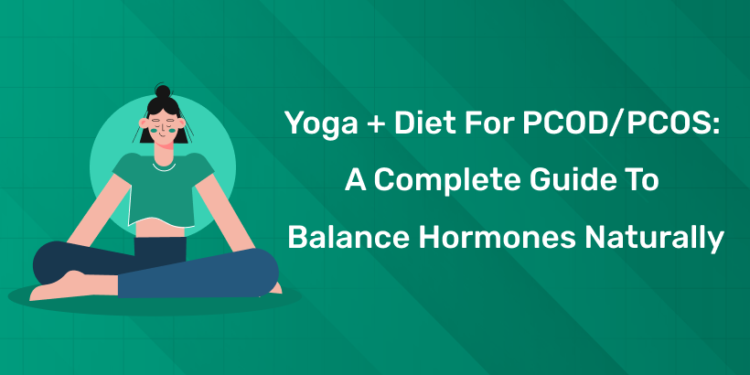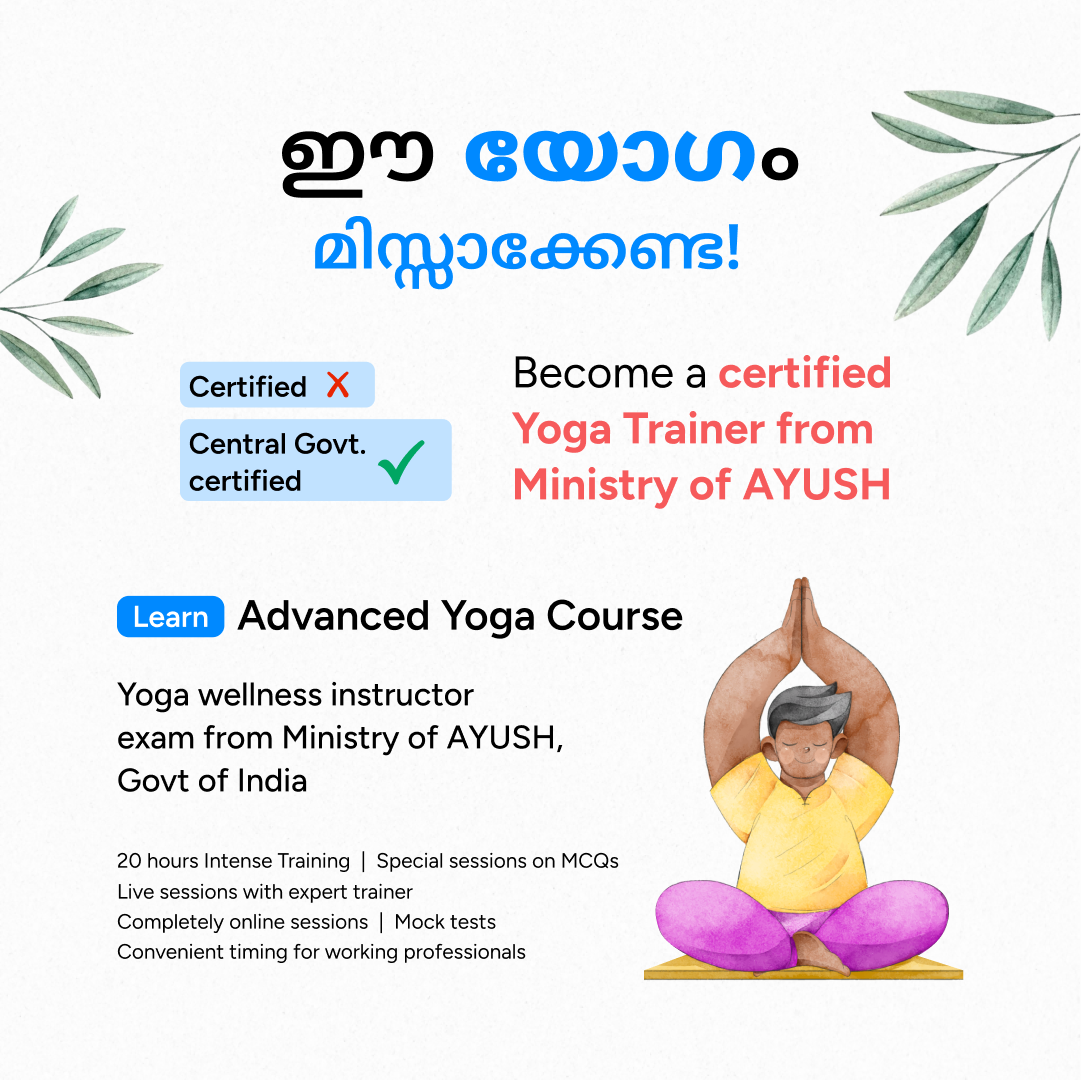Table of Contents
PCOD (Polycystic Ovarian Disease), often used interchangeably with PCOS (Polycystic Ovary Syndrome), is one of the most common hormone-related conditions among women in India today. Irregular periods, weight gain, acne, unwanted hair growth, mood swings, and fertility concerns can make life feel like a roller coaster. And because the symptoms vary from person to person, many women spend months (sometimes years) feeling confused about what’s really happening in their bodies.
Here’s the reassuring truth:
PCOD/PCOS is manageable.
Not overnight, not with one magic pill , but with consistent lifestyle support.
International clinical guidelines and medical reviews consistently point to lifestyle changes, especially diet, movement, weight management, and stress reduction, as first-line care for PCOS.
Yoga fits beautifully into this “first-line lifestyle care” because it addresses two core drivers of PCOD/PCOS:
- Metabolic health (insulin sensitivity, weight, inflammation)
- Stress + nervous system balance (cortisol, sleep, mood, cravings)
Research, including randomised trials and systematic reviews, show yoga can improve metabolic and psychological outcomes in PCOS, especially when practised regularly alongside lifestyle changes.
This blog is a practical, India-friendly guide for:
- Women living with PCOD/PCOS
- College students or working professionals trying to get cycles back on track
- Homemakers managing symptoms while juggling a busy home
- Aspiring yoga teachers who want to guide women safely and confidently
- Anyone looking for a balanced “Yoga + Diet” approach that’s realistic for Indian routines
Note: This blog is for education and wellness support, not a medical diagnosis or treatment replacement. Always consult your gynaecologist/endocrinologist for personalised care, especially if you’re trying to conceive or have severe symptoms.
Get Confident! Join Our Yoga Teacher Training Course!
PCOD vs PCOS: What’s the Difference?
In India, doctors and clinics often say “PCOD” while global literature uses “PCOS.” The terms overlap a lot.
- PCOD is usually framed as a disorder where the ovaries produce many immature eggs that turn into cysts.
- PCOS is a broader syndrome involving hormones, metabolism, and sometimes fertility problems.
Practically, for lifestyle management (diet + exercise + yoga), the approach is mostly the same. Medical guidelines treat it as a metabolic-endocrine condition strongly influenced by lifestyle.
Common symptoms include:
- Irregular or missed periods
- Weight gain, especially around the belly
- Excess facial/body hair
- Acne or oily skin
- Hair fall
- Sugar cravings
- Mood swings, anxiety
- Difficulty conceiving
You don’t need all symptoms to have PCOD/PCOS. Even 2–3 consistent symptoms can point toward it, which is why proper medical evaluation matters.
Why Lifestyle Is the “Real First Treatment”
1: Which of these is the primary goal of yoga practice?
If there is one line you should remember from this whole blog, it’s this:
Lifestyle intervention is first-line therapy for PCOS.
That means: before medicines, or along with medicines, the biggest improvements usually come from:
- Balanced weight or even a small weight reduction (around 5%) if overweight
- Regular physical activity (150–300 min/week moderate aerobic activity recommended)
- A sustainable diet that improves insulin sensitivity
- Stress reduction and better sleep
Yoga connects all these in one system.
Become a Certified Yoga Instructor
Yoga Teacher Training Course by Entri App: Master authentic yoga techniques, earn certification, and build a successful career as a professional yoga instructor.
Join Now!How Yoga Helps PCOD/PCOS (Science + Simple Logic)
Yoga doesn’t “cure” PCOD. But it can improve the body environment that causes symptoms.
Yoga helps through:
- Reducing stress and cortisol
Stress hormones worsen insulin resistance and cravings, and can disturb ovulation. Yoga practice is shown to reduce anxiety and stress in PCOS populations. - Improving insulin sensitivity
Many women with PCOD/PCOS have insulin resistance, even if they’re thin. Studies show yoga can help reduce insulin resistance markers over time. - Supporting weight management
Not by burning calories like HIIT, but by stabilising appetite, stress eating, sleep and metabolism. - Improving pelvic blood flow & endocrine balance
Asanas that compress and open the pelvic area may help circulation and glandular regulation. Reviews report improvements in hormonal and reproductive outcomes with yoga modules. - Regulating nervous system
PCOD often comes with anxiety, low energy, impulsive eating, and fatigue. Yoga shifts the body out of “fight/flight” into “rest/digest,” which is essential for hormone balance.
Best Yoga Asanas for PCOD/PCOS (Beginner-Friendly)
No need to do advanced poses. The key is regular practice, correct breathing, and consistency.
Commonly recommended PCOD yoga postures include Surya Namaskar, Bhujangasana, Dhanurasana, Supta Baddha Konasana, Setu Bandhasana and Paschimottanasana.
A. Pelvic-opening + hormone-supporting asanas
These help circulation in the lower abdomen and reduce stiffness:
- Supta Baddha Konasana (Reclining Butterfly Pose)
- Opens hips and pelvic floor
- Deep relaxation
- Great for menstrual regulation support in routine practice
- Opens hips and pelvic floor
- Baddha Konasana (Butterfly Pose)
- Simple, calming
- Helps flexibility and pelvic circulation
- Simple, calming
- Malasana (Garland Squat)
- Improves pelvic mobility
- Supports digestion and elimination
- Improves pelvic mobility
B. Gentle backbends (stimulate endocrine + reduce lethargy)
- Bhujangasana (Cobra Pose)
- Strengthens spine
- Opens chest (stress release)
- Mild abdominal toning
- Strengthens spine
- Setu Bandhasana (Bridge Pose)
- Activates glutes and core
- Supports thyroid/pituitary axis through overall hormonal stimulation
- Activates glutes and core
- Dhanurasana (Bow Pose) (if comfortable)
- Stronger abdominal tone
- Improves energy and digestion
- Stronger abdominal tone
C. Forward folds (calm nervous system + reduce cravings)
- Paschimottanasana (Seated Forward Bend)
- Deep calming effect
- Helps regulate stress eating patterns
- Deep calming effect
- Balasana (Child’s Pose)
- Restorative, grounding
- Good for anxiety and fatigue days
- Restorative, grounding
D. Dynamic flow
- Surya Namaskar (Sun Salutation)
- Full-body movement
- Improves metabolism and stamina
- Great entry into regular activity habits
- Full-body movement
Tip: If you’re new, start with 4–6 rounds slowly with breath awareness, not speed.
A Simple 35–40 Minute PCOD Yoga Routine (Daily / 5 days/week)
Warm-up (5 minutes)
- Neck rolls, shoulder rolls
- Cat-cow (Marjaryasana–Bitilasana)
- Hip circles
Main practice (25 minutes)
- Surya Namaskar – 4 to 8 rounds
- Bhujangasana – 2 rounds, 20–30 sec hold
- Setu Bandhasana – 2 rounds
- Baddha Konasana – 1–2 minutes slow flaps + still hold
- Supta Baddha Konasana – 2 minutes
- Paschimottanasana – 1 minute
- Balasana – 1 minute
Cool-down (5 minutes)
- Supine twist (both sides)
- Legs up the wall (Viparita Karani)
Relaxation (5 minutes)
- Shavasana with slow breathing
This is gentle enough for beginners and structured enough to build hormonal stability over time.
Become a Certified Yoga Instructor
Yoga Teacher Training Course by Entri App: Master authentic yoga techniques, earn certification, and build a successful career as a professional yoga instructor.
Join Now!Pranayama & Meditation for PCOD (Don’t Skip This)
PCOD is not only a physical condition , it’s deeply tied to stress response.
Pranayama and meditation are frequently included in therapeutic yoga programs for PCOS because they help down-regulate stress and support endocrine balance.
Best pranayama options:
- Nadi Shodhana (Alternate Nostril Breathing)
- Best for calming mind and stabilising hormones
- 5–7 minutes daily
- Best for calming mind and stabilising hormones
- Bhramari (Humming Bee Breath)
- Reduces anxiety quickly
- Helps sleep quality
- 3–5 minutes
- Reduces anxiety quickly
- Deep Belly Breathing
- Great after meals or during cravings
- 2 minutes anytime
- Great after meals or during cravings
Avoid strong Kapalbhati or fast breathing if you feel dizzy, have high BP, or are in a highly stressed state. A trained teacher can guide intensity safely.
PCOD Diet: An India-Friendly Approach That Works
Remember: doctors and guidelines don’t prescribe one “perfect PCOS diet,” but they consistently recommend healthy eating patterns that support weight balance and insulin sensitivity.
Core diet principles for PCOD:
- Stabilise blood sugar
- Reduce refined carbs
- Add fibre + protein to every meal
- Reduce refined carbs
- Reduce inflammation
- More whole foods
- Less processed snack culture
- More whole foods
- Support gut health
- More seasonal vegetables
- Fermented foods (curd, buttermilk, kanji)
- More seasonal vegetables
- Eat consistently
- Long gaps → cravings
- Skipping breakfast → sugar crashes
- Long gaps → cravings
What to Eat More (Indian Foods)
A. High-fibre carbs (slow energy)
- Millets: ragi, jowar, bajra
- Brown rice / red rice
- Whole wheat / multigrain rotis
- Oats, barley, quinoa (if you like)
- Sweet potato in moderation
B. Protein at every meal
- Dal varieties: moong, masoor, chana, toor
- Sprouts
- Paneer, tofu
- Eggs, fish, chicken (if non-veg)
- Greek yogurt / thick curd
C. Healthy fats
- Groundnut, sesame, coconut in small portions
- Ghee (1 tsp/day is fine for most people)
- Nuts: almonds, walnuts
- Seeds: flax, chia, sunflower, pumpkin
D. PCOD-friendly vegetables
Aim for 3–4 cups/day:
- Greens: spinach, amaranth, drumstick leaves
- Cruciferous: cabbage, cauliflower, broccoli
- Local veggies: beans, carrot, brinjal, ladies finger, bottle gourd
- Tomatoes, onions, bell peppers
E. Fruits (controlled portions)
- Papaya, guava, apple, orange
- Berries if available
- Avoid very large portions of mango, grapes, chikoo daily
Foods to Limit (Not “Ban Forever”)
- White bread, maida snacks, bakery items
- Sugary tea/coffee multiple times
- Sweet beverages, packaged juices
- Deep fried evening snacks daily
- Excess dairy sweets (milk-based desserts daily)
You don’t have to become extreme.
The goal is 80% consistent eating, not perfection.
A Sample PCOD Diet Day (South-India Friendly)
Morning (on waking)
- Warm water + soaked fenugreek (methi) seeds or lemon water
Breakfast (don’t skip)
- 2 idlis + sambar + chutney
OR
- Ragi dosa + peanut chutney
OR
- Veg oats upma + 1 boiled egg / paneer cubes
Mid-morning snack
- 1 fruit (guava/apple/orange)
- few nuts
Lunch
- 1 cup red/brown rice OR 2 chapatis
- 1 cup dal + vegetable poriyal
- Curd or buttermilk
Evening snack (PCOD-safe)
- Sundal / roasted chana
- herbal tea if you want
- avoid biscuits daily
Dinner (light)
- Veg soup + 1 chapati
OR
- Moong dal khichdi + ghee + salad
Before bed
- 5 minutes Nadi Shodhana breathing
Simple, affordable, culturally familiar.
4–6 Week Yoga + Diet Roadmap for PCOD
Week 1–2: Build consistency
- Yoga 25–30 min, 5 days/week
- Replace refined snacks with one healthy option
- Fix sleep timing
Week 3–4: Metabolic support
- Increase Surya Namaskar rounds
- Add more protein to breakfast and lunch
- Walk 20–30 minutes daily (guidelines recommend regular aerobic activity)
Week 5–6: Hormone rhythm
- Track cycle changes and energy levels
- Observe cravings and stress triggers
- Add short evening pranayama sessions
This is where most women start feeling:
- better energy
- reduced cravings
- better mood
- improved digestion
- gradual cycle regulation
Teaching PCOD Yoga Safely
If you’re an aspiring teacher, here are a few professional tips:
- Start gentle
Many women with PCOD feel fatigued or anxious. Start with restorative + breath awareness. - Avoid shaming weight
PCOD is not just about weight. Even lean PCOD exists. - Teach consistency, not intensity
A 30-minute daily practice beats a 2-hour once-a-week class. - Offer modifications
Knee pain, back pain, heavy flow days, always provide options. - Use breath as the anchor
Teach women to return to breath when emotions, cravings, or stress spike. - Encourage medical overlap
Never ask students to stop medicines. Encourage collaboration with doctors.
Therapeutic yoga for PCOS is best practiced alongside lifestyle and medical guidance.
How Entri Yoga TTC Helps You Teach PCOD-Focused Wellness
If your goal is not only to practice yoga for PCOD but to teach it professionally, you need more than YouTube knowledge. You need:
- anatomy basics
- endocrine and metabolic awareness
- safe sequencing
- breath science
- cueing and class structure
- real practicum experience
The Entri Yoga TTC course aligns with this because it trains you in:
- Correct alignment and teaching methods
- Structured sequencing for different needs
- Pranayama + meditation facilitation
- Practical teaching practice so you gain confidence in front of real students
With this foundation, you can responsibly guide women dealing with PCOD/PCOS , in studios, online classes, corporate wellness, or community settings.
Key Takeaways
- PCOD/PCOS is strongly influenced by lifestyle; diet + activity + stress management are first-line care.
- Yoga supports PCOD by reducing stress, improving insulin sensitivity, and balancing nervous system regulation.
- Best asanas include Surya Namaskar, Bhujangasana, Setu Bandhasana, Supta Baddha Konasana, Paschimottanasana and restorative poses.
- Pranayama (Nadi Shodhana, Bhramari) is key for cravings, sleep and cortisol control.
- PCOD diet should focus on stable blood sugar, high fibre, adequate protein, and low processed foods.
- You don’t need extreme diets; 80% consistency wins.
- A 4–6 week steady routine shows meaningful improvements in energy, mood, and cycle rhythm.
- Aspiring yoga teachers should learn therapeutic sequencing and safe modifications; Entri Yoga TTC helps build that professional capability.
Final Words
PCOD can feel frustrating because it touches everything: body image, energy, mood, confidence, and sometimes fertility. But when you treat it like a lifestyle rhythm problem rather than “a disease to fear,” things change.
Start simple:
- 30–40 minutes of yoga daily
- 2 smart food swaps per day
- 1 breathing practice before sleep
That’s enough to shift your system. Slowly, your body begins to trust you again.
And if you want to guide other women through this journey professionally, step into structured learning through the Entri Yoga TTC course, so your teaching is safe, confident and truly transformative.
Become a Certified Yoga Instructor
Yoga Teacher Training Course by Entri App: Master authentic yoga techniques, earn certification, and build a successful career as a professional yoga instructor.
Join Now!Frequently Asked Questions
Can yoga help cure PCOD?
Yoga cannot cure PCOD, but it can significantly reduce symptoms by balancing hormones, lowering stress, improving metabolism, and regulating menstrual cycles.
Which yoga poses are best for PCOD?
Butterfly Pose, Bridge Pose, Cobra Pose, Malasana, and Child’s Pose are highly effective for improving pelvic circulation and hormonal balance.
How often should I do yoga for PCOD?
Practising yoga 5–6 days a week for 20–40 minutes is ideal. Consistency matters more than intensity.
Can beginners do yoga for PCOD?
Yes. Most PCOD-friendly asanas are gentle and beginner-friendly. However, it is best to learn under trained guidance initially.
Which pranayama is good for PCOD?
Anulom Vilom, Bhramari, Deep Belly Breathing and Kapalbhati (only with guidance) are helpful for hormonal and emotional balance.
What foods should I avoid if I have PCOD?
Avoid sugar, processed snacks, maida-based foods, deep-fried items, excessive caffeine, and packaged fruit juices.
What are the best foods for a PCOD diet in India?
Millets, vegetables, fruits, paneer, dal, nuts, seeds, ghee, coconut, turmeric, and whole grains are excellent choices.
Can diet alone cure PCOD?
Diet improves insulin resistance and inflammation, but PCOD management works best with a combination of diet + yoga + lifestyle changes.
How can aspiring yoga teachers learn to guide PCOD students?
Joining a structured program like Entri Yoga TTC helps teachers learn anatomy, sequencing, safety cues, and therapeutic yoga methods for women’s health.





























